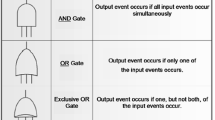Abstract
The ever-increasing complexity of production systems, together with the need to obtain efficient processes with limited costs, has led companies to develop custom tools for process control and management. Even for risk assessment, the traditional models often are overcome by methods that are best suited to specific needs. In this context, the aim of this paper was to propose a new model, which we call the global safety improve risk assessment (G-SIRA). This model can classify risks and identify corrective actions that allow the best risk reduction at the lowest cost. The proposed model, which is based on improvements to previous research, uses the analytic hierarchy process approach to develop a valid and simple tool for risk management. The G-SIRA method has been tested in a real-world application, i.e., it was applied to all of the processes of a textile company, and the results were compared with those obtained from the classical approach failure mode, effects, and criticality analysis. The comparison clearly showed the effectiveness of the proposed model.




Similar content being viewed by others
References
M. Fera, R. Macchiaroli, Appraisal of a new risk assessment model for SME. Saf. Sci. 48(2010), 1361–1368 (2010)
T. Aven, Risk assessment and risk management: review of recent advances on their foundation. Eur. J. Oper. Res. 253(2016), 1–13 (2016)
M.H. Whittaker, Risk assessment and alternatives assessment: comparing two methodologies. Risk Anal. 35(2), 2129–2136 (2015)
E. Garbolino, J.P. Chery, F. Guarnieri, A simplified approach to risk assessment based on system dynamics: an industrial case study. Risk Anal. 36(1), 16–29 (2016)
G. Carmignani, An integrated structural framework to cost-based FMECA: the priority-cost FMECA. Reliab. Eng. Syst. Saf. 94(2009), 861–871 (2009)
T.L. Saaty, The Analytic Hierarchy Process: Planning, Priority Setting, Resource Allocation (McGraw-Hill, New York, 1980)
F. De Felice, A. Petrillo, Proposal of a structured methodology for the measure of intangible criteria and for decision making. Int. J. Simul. Process Model. 9(3), 157–166 (2014)
H.C. Liu, J.X. You, X.Y. You, M.M. Shan, A novel approach for failure mode and effects analysis using combination weighting and fuzzy VIKOR method. Appl. Soft Comput. 28, 579–588 (2015)
P.-S. Chen, M.-T. Wu, A modified failure mode and effects analysis method for supplier selection problems in the supply chain risk environment: a case study. Comput. Ind. Eng. 66, 634–642 (2013)
M. Bevilacqua, M. Braglia, The analytic hierarchy process applied to maintenance strategy selection. Reliab. Eng. Syst. Saf. 70, 71–83 (2000)
Y. Lin, D. Quan, P. Chen, The improved failure mode effects and criticality analysis method based on analytic hierarchy process. 65th International Astronautical Congress 2014: Our World Needs Space, vol. 9, IAC 2014, Toronto, Canada; 29 September–3 October, 2014, pp. 6169–6180
S. Zhang, Q. Zeng, G. Zhang, A new approach for prioritization of failure mode in FMECA using encouragement variable weight AHP. Appl. Mech. Mater. 289(2013), 93–98 (2013)
P. Trucco, M. Cavallin, F. Lorenzi, A standardised FMECA and risk factors monitoring method for clinical risk assessment: results from a multi centric application. 11th International Probabilistic Safety Assessment and Management Conference and the Annual European Safety and Reliability Conference 2012, vol. 7, ESREL 2012, pp. 5966–5975
F. Zammori, R. Gabbrielli, ANP/RPN: a multi criteria evaluation of the risk priority number. Qual. Reliab. Eng. Int. 28(1), 85–104 (2012)
A. Silvestri, F. De Felice, A. Petrillo, Multi-criteria risk analysis to improve safety in manufacturing systems. Int. J. Prod. Res. 50(17), 4806–4821 (2012)
C. Madu, Competing through maintenance strategies. Int. J. Qual. Reliab. Manag. 17(9), 937–948 (2000)
P.C. Teoh, K. Case, Failure modes and effects analysis through knowledge modeling. J. Mater. Process. Technol. 153–154(2004), 253–260 (2004)
P.N. Muchiri, L. Pintelon, H. Martinb, A.M. De Meyer, Empirical analysis of maintenance performance measurement in Belgian industries. Int. J. Prod. Res. 48, 5905–5924 (2010)
D.C. Aguiar, H.J.C. de Souza, V.A.P. Salomon, An AHP application to evaluate scoring criteria for failure. Int. J. Anal. H. Process 2, 1936–6744 (2010)
M. Ben-Daya, A. Raouf, A revised failure mode and effect analysis model. Int. J. Qual. Reliab. Manag. 13(1), 43–47 (1996)
W. Gilchrist, Modelling failure modes and effects analysis. Int. J. Qual. Reliab. Manag. 10(5), 16–23 (1993)
C.E. Pelaez, J.B. Bowles, Using fuzzy logic for system criticality analysis, in Proceedings of the IEEE Annual Reliability and Maintainability Symposium, 1994, pp. 449–55
J.B. Bowles, An assessment of RPN prioritization in a failure modes effects and criticality analysis. Reliability and maintainability symposium, 2003, pp. 380–386
T.L. Saaty, Decision Making with Dependence and Feedback: The Analytic Network Process (RWS, Pittsburgh, 1996)
A. Silvestri, F. De Felice, D. Falcone, G. Di Bona, R.A.M.S. Analysis in a sintering plant by the employment of a new reliability allocation method modelling and simulation, 2004, Marina del Rey
J. Fleischer., U. Weismann, S. Niggeschmidt, Calculation and optimisation model for costs and effects of availability relevant service elements, Proceedings of 13th CIRP International Conference on Life Cycle Engineering (LCE2006), 31 May–2 June, 2006, Leuven, Belgium. Leuven: Acco, pp. 675–680.
Author information
Authors and Affiliations
Corresponding author
Rights and permissions
About this article
Cite this article
Di Bona, G., Silvestri, A., De Felice, F. et al. An Analytical Model to Measure the Effectiveness of Safety Management Systems: Global Safety Improve Risk Assessment (G-SIRA) Method. J Fail. Anal. and Preven. 16, 1024–1037 (2016). https://doi.org/10.1007/s11668-016-0185-z
Received:
Published:
Issue Date:
DOI: https://doi.org/10.1007/s11668-016-0185-z




